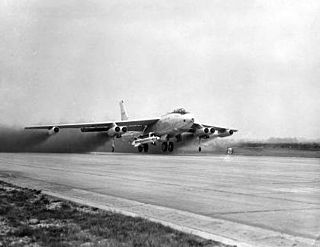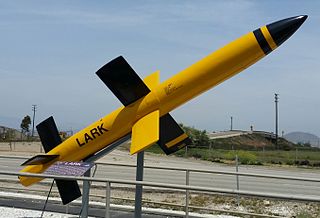
The Avro Blue Steel was a British air-launched, rocket-propelled nuclear armed standoff missile, built to arm the V bomber force. It allowed the bomber to launch the missile against its target while still outside the range of surface-to-air missiles (SAMs). The missile proceeded to the target at speeds up to Mach 3, and would trigger within 100 m of the pre-defined target point.

A missile is an airborne ranged weapon capable of self-propelled flight aided usually by a propellant, jet engine or rocket motor.

The Douglas GAM-87 Skybolt was a hypersonic air-launched ballistic missile (ALBM) developed by the United States during the late 1950s. The basic concept was to allow US strategic bombers to launch their weapons from well outside the range of Soviet defenses, as much as 1,000 miles (1,600 km) from their targets. To do this in an air-launched form, a lightweight thermonuclear warhead was needed. Initially, the W47 from the Polaris missile was selected, but it was later replaced by the W59 from the Minuteman missile.

Anti-satellite weapons (ASAT) are space weapons designed to incapacitate or destroy satellites for strategic or tactical purposes. Although no ASAT system has yet been utilized in warfare, a few countries have successfully shot down their own satellites to demonstrate their ASAT capabilities in a show of force. ASATs have also been used to remove decommissioned satellites.

An air-to-surface missile (ASM) or air-to-ground missile (AGM) is a missile designed to be launched from military aircraft at targets on land or sea. There are also unpowered guided glide bombs not considered missiles. The two most common propulsion systems for air-to-surface missiles are rocket motors, usually with shorter range, and slower, longer-range jet engines. Some Soviet-designed air-to-surface missiles are powered by ramjets, giving them both long range and high speed.

The McDonnell ADM-20 Quail was a subsonic, jet powered, air-launched decoy cruise missile built by McDonnell Aircraft Corporation. The Quail was designed to be launched by the Boeing B-52 Stratofortress strategic bomber and its original United States Air Force designation was GAM-72.
Weapon System was a United States Armed Forces military designation scheme for experimental weapons before they received an official name — e.g., under a military aircraft designation system. The new designator reflected the increasing complexity of weapons that required separate development of auxiliary systems or components.

The Convair XGAM-71 Buck Duck was an air-launched decoy missile that was developed by Convair in the early 1950s. It was intended to have the same radar signature as the Strategic Air Command's B-36 bomber, thereby allowing it to disrupt the enemy's air defenses and dilute their effort to shoot down an incoming bomber fleet.

The ASM-135 ASAT is an air-launched anti-satellite multistage missile that was developed by Ling-Temco-Vought's LTV Aerospace division. The ASM-135 was carried exclusively by United States Air Force (USAF) F-15 Eagle fighter aircraft.

An air-launched ballistic missile (ALBM) is a ballistic missile launched from an aircraft. An ALBM allows the launch aircraft to stand off at long distances from its target, keeping it well outside the range of defensive weapons like anti-aircraft missiles and interceptor aircraft. Historically, once launched the missile was essentially immune to interception due to a lack of capable anti-ballistic missiles, with those few that did exist being limited to known static positions. This combination of features allowed a strategic bomber to present a credible deterrent second-strike option in an era when improving anti-aircraft defences appeared to be rendering conventional bombers obsolete. However, by the 1990s surface-to-air missile technology had innovated to the point of allowing the interception of such weapons from road mobile systems, albeit at a lower PoK. By the early 21st century capable, dedicated, ABM systems from several nations had been deployed in significant numbers, spurring further innovation in hypersonic glide vehicles to penetrate such systems and keep ballistic missiles capable.

Project Kingfisher was a weapons-development program initiated by the United States Navy during the latter part of World War II. Intended to provide aircraft and surface ships with the ability to deliver torpedoes to targets from outside the range of defensive armament, six different missile concepts were developed; four were selected for full development programs, but only one reached operational service.

The GAM-63 RASCAL was a supersonic air-to-surface missile that was developed by the Bell Aircraft Company. The RASCAL was the United States Air Force's first nuclear armed standoff missile. The RASCAL was initially designated the ASM-A-2, then re-designated the B-63 in 1951 and finally re-designated the GAM-63 in 1955. The name RASCAL was the acronym for RAdar SCAnning Link, the missile's guidance system. The RASCAL project was cancelled in September 1958.

The LBD-1 Gargoyle was an American air-to-surface missile developed during World War II by McDonnell Aircraft for the United States Navy. One of the precursors of modern anti-ship missiles, it was extensively used as a test vehicle during the late 1940s.

The Bold Orion missile, also known as Weapons System 199B (WS-199B), was a prototype air-launched ballistic missile (ALBM) developed by Martin Aircraft during the 1950s. Developed in both one- and two-stage designs, the missile was moderately successful in testing, and helped pave the way for development of the GAM-87 Skybolt ALBM. In addition, the Bold Orion was used in early anti-satellite weapons testing, performing the first interception of a satellite by a missile.

The Alpha Draco missile, also known as Weapons System 199D (WS-199D), was an experimental ballistic missile developed by McDonnell Aircraft in the late 1950s to investigate the aerodynamic physics of the boost-glide reentry trajectory. Three test flights were conducted in 1959, of which two were successful.

Weapons System 199 (WS-199) was a weapons development program conducted by the United States Air Force to research and develop new strategic weapons systems for Strategic Air Command. Two air-launched and one ground-launched vehicles were developed as part of the program. While none entered production, they assisted in the development of both the GAM-87 Skybolt air-launched ballistic missile and that of re-entry vehicles for ballistic missiles.

The SAM-N-2 Lark project was a solid-fuel boosted, liquid-fueled surface-to-air missile developed by the United States Navy to meet the kamikaze threat. It was developed as a crash program to introduce a medium-range defensive layer that would attack targets between the long-range combat air patrols and short-range anti-aircraft artillery. This produced a design with roughly 30 miles (48 km) maximum range and subsonic performance, suitable for attacks against Japanese aircraft.

The RTV-A-3 NATIV was an experimental missile developed by North American Aviation for the United States Air Force in the late 1940s to test and evaluate guided missile technologies. The North American Test Instrumentation Vehicle (NATIV) was developed as part of the MX-770 program which was created towards the end of WWII with the intent of developing a long range missile.

The Lobber was a surface-to-surface cargo missile developed during the mid 1950s by Convair for use by the United States Army. Intended to deliver supplies to troops in combat, it was successfully tested, but failed to go into production.

The AUM-N-6 Puffin, also known as Kingfisher F and AUM-6, was an anti-ship and anti-submarine missile developed for use by the United States Navy in the late 1940s. Pulsejet-powered and intended to allow an aircraft to launch a torpedo or bomb from stand-off range, it was flight-tested but failed to enter operational service.



















